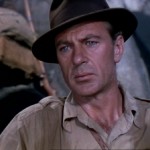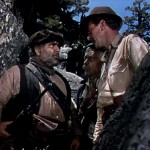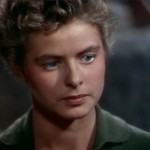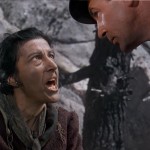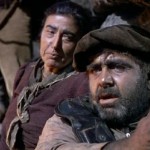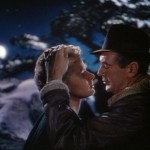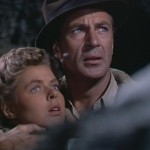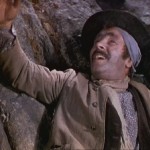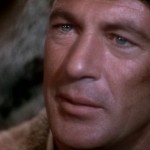
For Whom the Bell Tolls – 1943
On the one hand… Yay Technicolor! On the other, maybe we should hold off until we get it right. I know how completely irrational that statement is. After all, they would never have gotten it right without going through these beginning steps. It was a necessary process that had to happen before the art of color films could become what they are today. But all that being said, there were definitely issues with the color.
Just as in the 1937 Best Picture nominee, A Star is Born, everything was too dark unless it was being filmed in direct sunlight. Much of the film took place either inside a cave or during the hours between dusk and dawn. It seemed that the filmmakers didn’t really understand the concept of backlighting. There were times when the actors were nearly too dark to see, though the mountains in the background stood out like a photo-negative.
The film starred Academy Award nominee veteran, Gary Cooper as Roberto Jordan, an American fighting in the Spanish Civil War during the late 1930s. He is a demolitions expert who is assigned to blow up a strategically valuable bridge. He is ordered to meet with a republican guerrilla unit in the mountains surrounding the bridge three days before the deed is to take place. It is supposed to coincide with an air raid by the Soviet Union.
So far, it sounds like an exciting concept that promises plenty of action and suspense. But I think that Hollywood must have had a hand in what the majority of the film spent time on. Living with the rebels in their cave is Maria, played by Ingrid Bergman. She is a young girl who had been gang raped by men of the fascist coalition at the outbreak of the war.
Bergman did a fantastic job portraying the emotions of the damaged Maria. The scene in which she tells of the deaths of her parents, the humiliation of having her head shaved, and the rape was surprisingly well done. I really felt for her character. But her failing was her accent. She was supposed to be Spanish, and she tried to play her part with an appropriate accent, but her dialogue came out muddled and inconsistent.
However, I’m sorry to say that I thought Cooper to be the film’s weakest link. I have a feeling that one of the things that made him such a popular actor was his ability to portray the strong, silent type. He displayed little emotion and always did the right thing, no matter how difficult. But in this role, I wanted to see something more. An actor needs to know how to use his facial expressions to make the emotions of the character clear to the audience. Sure, one could go overboard, as was necessary in the silent era of film making, but his performance was like the opposite extreme. He was so stone-faced that I got nothing from him at all.
On the flip-side, I really liked two other characters that were integral to the plot. The leaders of the guerrilla unit were Pablo and his common-law wife, Pilar, brilliantly played by Akim Tamiroff and Katina Paxinou, respectively. They both did such a fantastic job that in my book, they completely made up for Cooper’s lack of emotion and Bergman’s bad Spanish accent.
Pablo was the weak-willed drunkard who led the rebel band. Pilar was the homely tower of strength that wrested control from her traitorous husband. At first I didn’t like Tamiroff, but I eventually realized that it was his character that I didn’t like, and that the actor did a wonderful job of playing the bad guy role.
But it was Paxinou that really stole the show or me. She was strong, wise, practical, passionate about her position in the war, and able to kick butt with the best of them when the fighting started. The actress was really memorable and her performance was amazing. In fact, she won the Academy Award for Best Supporting Actress that year, an honor that was well deserved.
The first two-thirds of the movie dealt with Roberto’s integration into the guerrilla camp, the romance between Roberto and Maria, and Pablo’s various betrayals. Everything was character driven, and not much really happened. But the final third of the movie really kicked up the action. There were gun fights, air raids, tank battles, and, of course, an exploding bridge, which was exciting to watch.
And as a little afterthought, I need to mention the character of Rafael, the devil-may-care gypsy member of the guerrilla rebels, played by Mikhail Rasumny. He played a very fun and likable roll. After all, he was the comic relief and had some amusing moments. However, the manner of his death ultimately made him out to be a moron. Watch the film and you’ll see what I mean.
